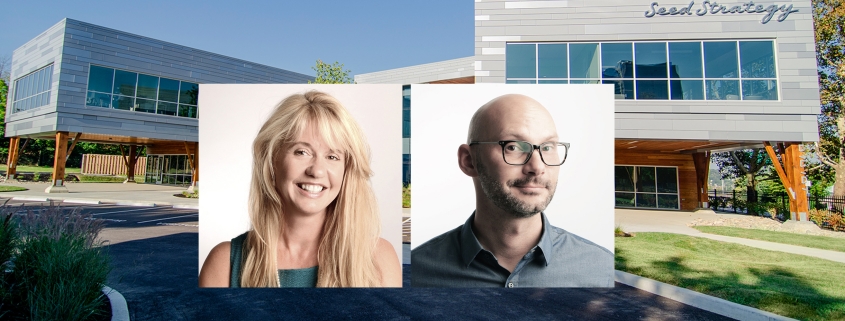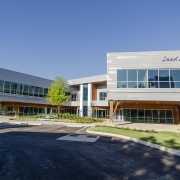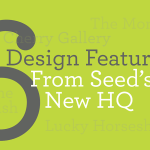The Modern Treehouse: A Q&A with the Minds Behind Seed Strategy’s New Headquarters
A sanctuary for the creative spirit. A purpose-built space for innovation. A catalyst for changing perspectives. These were some of the objectives in mind when Seed’s founder and CEO, Susan Jones, and Seed’s EVP, Chief Strategy Officer, Eric Scheer, set out to collaborate with their team of architects to create the growth acceleration firm’s new downtown Cincinnati headquarters.
We sat down with Jones and Scheer to discuss the creative process that went into planning and designing the new structure, and to understand what makes visiting this “Modern Treehouse” as magical as the treetop retreats you remember from childhood.
What was the inspiration behind the architectural design?
SJ: Our original inspiration was a treehouse. When we decided to move from our previous location among the rolling Kentucky hills, we knew that we’d have to leave the trees behind for the city. We concepted this idea of a Modern Treehouse to bring a little bit of the forest with us.
ES: In the design plan, we tried to blend playfulness and sophistication to incorporate some of the iconic elements of a treehouse into the building. For example, the big wooden support beams are like tree trunks in the forest. Floor-to-ceiling windows—many at foliage height—bring the outside in, helping us all feel connected to nature, even in the midst of the bustling city.
The concept of a treehouse has always been special to Seed, hasn’t it?
SJ: Yes, absolutely. We like to think of treehouses as a magical place where we can all reconnect to our inner child… to a time when we were our most curious and creative.
How did you select the tree that is featured so prominently in the central courtyard of the building?
SJ: That tree holds a lot of symbolism for us at Seed. At the core of every business is a single idea—a seed—from which everything grows. The tree on our campus represents that growth. It’s a red oak, which can live for more than 300 years.
The tree’s placement also has significance. As you approach, it almost looks like the building is embracing the tree. The “arms” of our building extend outward around the tree, as if protecting it, just as we shelter and nurture ideas while they grow and develop.
You’ve described the office as purpose-built for the flow of innovation. How did that idea come to life in the space?
ES: When we first started working with the architects, they shared a standard process for determining how spaces within a workplace are typically laid out… what kinds of rooms and functions are usually grouped together.
Then, we pretty much threw that out [Laughs]. We knew that our work requires something a little different. The opportunity to interact with one another, and also to have quiet time. We put all the conference rooms at the far corners to encourage people to flow throughout the building. And just like every Seed office building before, each Seedling gets his or her own office with a door and a window. Nothing is how you’d expect it to be, but it’s perfect for how Seed flows to the work.
Wow, every employee has an office?
SJ: I’ve always believed that your environment plays an important role in how you work and how you think. Providing each individual with their own space to make their own, and to have the time and space to think, has been instrumental in our work at Seed.
It sounds like a lot of care has gone into ensuring people—and ideas—have room to grow. How else have you helped to foster this feeling of a “creative sanctuary”?
SJ: Helping people feel connected to a place is all about the details. We’ve incorporated a lot of handmade, personal touches throughout the building that provide the special, home-y, feel—so even during the high-energy flow of innovation work, we can still find those moments of peace and introspection.
For instance, my husband made the lobby table by hand. Eric designed both of the lobbies, and he and I painted the floors ourselves. My father’s art is hanging all around the building, depicting different vantage points of Cincinnati. Every material, angle, finish, feature and décor item was chosen with a purpose.
What will be the greatest benefit of being located in downtown Cincinnati?
ES: Access to culture. We are right in the center of the action, and we can look out our windows and witness the concepts we work with every day happening in real time. Whether it’s e-mobility, pop-up restaurants, concept stores in Over-The-Rhine that you pass on your way to lunch… many of these things are representations of things we have worked on, or emerging trends that will continue to shape our future.
SJ: Plus, we now share a campus with our parent company, Burke, Inc. Our work is so interconnected, so now those synergies and partnerships can happen even more fluidly as we flow between the two buildings.
What can clients look forward to with this new space built for innovation?
ES: Every space in the building is designed to enable the energy, flow and evolution of innovation processes. From informal meeting spaces, to ideation rooms, to roll-up-your-sleeves-and-work spaces, we can accommodate a range of agile processes and project types. We have devoted sound and photography studios, client-ready offices, large event spaces. Whatever needs to happen, we can make happen in this new space.
SJ: We also welcome any of our clients, new or old, to come visit—even if it’s just to clear your head. Like Seed as a company, the building has a special energy. When visitors spend time here, they can feel a change in perspective. We hope that this building can not only be a sanctuary for Seedlings’ creative spirits, but also for all who enter.
Angela Jones is a VP, Creative at Seed Strategy and Managing Editor for Seed’s e-mag, The Fire Theft Project: Conversations on Creativity. She specializes in capturing the essence of new ideas, and helping lead teams towards a fully realized creative vision.
Connect with us! Follow Seed Strategy on our LinkedIn, Twitter, Facebook and Instagram pages.





